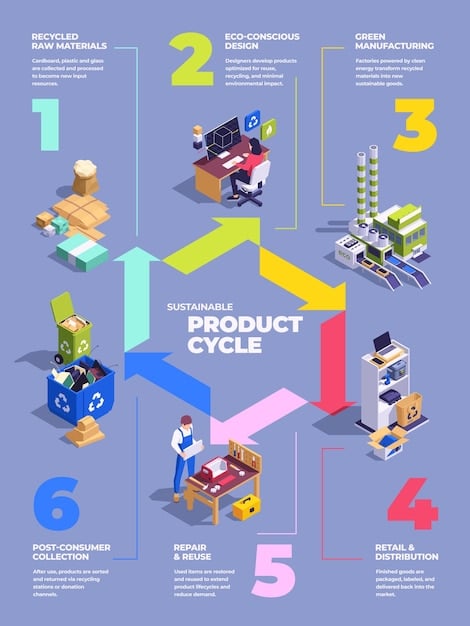E-commerce Packaging Waste: How 2025 Regulations Will Impact Your Business

E-commerce Packaging Waste Under Scrutiny: Will the Proposed Federal Regulations Affect Your Business in 2025? – This article examines how looming federal regulations targeting e-commerce packaging waste in 2025 could reshape business practices, emphasizing sustainable solutions and potential economic impacts for companies in the United States.
The increasing volume of e-commerce packaging waste under scrutiny: will the proposed federal regulations affect your business in 2025? This situation has captured the attention of policymakers, environmental groups, and consumers alike. As 2025 approaches, new federal regulations are expected to significantly impact how e-commerce businesses manage their packaging.
Understanding the Growing E-commerce Packaging Waste Problem
The rise of e-commerce has propelled convenience to new heights, but it has also brought a significant surge in packaging waste. This waste includes cardboard boxes, plastic wraps, packing peanuts, and other materials used to protect products during shipping.
Let’s take a look at some of the key drivers behind this growing problem and its environmental consequences.
The Exponential Growth of E-commerce
Fueling this waste surge is the remarkable growth of e-commerce. As more consumers turn to online shopping for everything from groceries to electronics, the demand for packaging increases proportionally.
The Environmental Impact
The environmental consequences of e-commerce packaging waste are far-reaching. Landfills are overflowing, and the extraction of raw materials to produce packaging contributes to deforestation, pollution, and greenhouse gas emissions.

Here are some points related with the environmental impact:
- Resource Depletion: Packaging production consumes vast quantities of resources, including trees, petroleum, and water.
- Pollution: Manufacturing processes release pollutants into the air and water, while improper disposal leads to soil and water contamination.
- Climate Change: The production and transportation of packaging materials contribute to greenhouse gas emissions, exacerbating climate change.
Addressing the e-commerce packaging waste problem requires a comprehensive approach involving businesses, consumers, and policymakers. By adopting sustainable packaging practices, reducing waste generation, and implementing effective recycling programs, we can mitigate the environmental impact of e-commerce and create a more sustainable future.
Federal Regulations on E-commerce Packaging: What’s on the Horizon?
As the environmental impact of e-commerce packaging waste becomes more apparent, federal regulators are stepping in to address the issue. While specific regulations are still in development, the direction is clear: businesses will face increasing pressure to reduce packaging waste and adopt more sustainable practices.
Understanding the current regulatory landscape and potential future regulations is crucial for e-commerce businesses to prepare for the changes ahead.
Current E-commerce Packaging Regulations in the United States
While there isn’t a comprehensive federal law specifically targeting e-commerce packaging waste, some existing regulations indirectly impact packaging practices.
Existing regulations include topics as:
- The Resource Conservation and Recovery Act (RCRA): This act governs the management of solid and hazardous waste, including packaging materials.
- State-Level Regulations: Several states have implemented their own packaging regulations, such as extended producer responsibility (EPR) laws that hold producers responsible for the end-of-life management of their packaging.
Potential Federal Regulations in 2025
Looking ahead to 2025, there is growing momentum for federal regulations that directly address e-commerce packaging waste.

Here are some possible regulations:
- Mandatory Recycled Content: Requiring packaging to contain a certain percentage of recycled materials.
- Packaging Reduction Targets: Setting targets for businesses to reduce the overall volume of packaging used.
- Standardized Labeling: Implementing standardized labeling systems to improve recycling rates and educate consumers about proper disposal.
By proactively addressing packaging waste and embracing sustainable practices, businesses can not only comply with future regulations but also enhance their brand image and gain a competitive advantage in the marketplace. Staying informed about potential regulatory changes and engaging in industry discussions will be essential for businesses to adapt and thrive in an evolving regulatory landscape.
How Proposed Regulations Could Affect E-commerce Businesses
The proposed federal regulations on e-commerce packaging waste have the potential to significantly impact businesses. Understanding the potential consequences is essential for preparing to adapt to the new regulatory landscape.
Let’s examine some of the possible changes and challenges that businesses in the e-commerce sector might encounter.
Increased Costs
Complying with new packaging regulations could lead to increased costs for e-commerce businesses. These costs could be related to the switch to more sustainable packaging options, investments in new equipment, or expenditures for recycling management strategies.
Operational Changes
Businesses can anticipate having to make operational adjustments in order to comply with the standards set by the new regulations. Such adjustments might concern the assessment of current packaging procedures, the modification of supply chains, and the training of workers in more ecologically responsible packaging methods.
Operational changes includes topics such as:
- Packaging Redesign: Businesses may need to redesign their packaging to reduce material usage, optimize recyclability, and minimize environmental impact.
- Supply Chain Adjustments: Shifting to sustainable packaging may require businesses to work with new suppliers or adjust their existing supply chains.
E-commerce businesses need to assess their current packaging operations, identify areas for improvement, and develop strategies for complying with the new regulations. By taking proactive steps, businesses can minimize the potential disruptions and costs associated with regulatory changes.
Sustainable Packaging Alternatives for E-commerce
As e-commerce businesses face increasing pressure to reduce packaging waste, adopting sustainable packaging alternatives becomes essential. Fortunately, a wide range of eco-friendly options are available.
Exploring these alternatives can help businesses minimize their environmental impact while meeting customer expectations for responsible practices.
Recycled Cardboard and Paper
Using recycled cardboard and paper is a straightforward way for companies to lower their carbon footprint and advocate for waste reduction. Cardboard made from recycled materials is identical to its original counterpart, but it uses less water, energy, and trees during manufacturing.
Biodegradable Packaging Peanuts
Traditional polystyrene packaging peanuts are a major source of plastic waste. Biodegradable packaging peanuts, made from cornstarch or other plant-based materials, offer a sustainable alternative.
Other alternatives include:
- Mushroom Packaging: Packaging grown from mycelium, the root structure of mushrooms, is fully compostable and offers excellent cushioning.
- Seaweed Packaging: Seaweed-based packaging is biodegradable and can even be used as fertilizer after use.
Strategies for Reducing Packaging Waste in Your Business
Beyond adopting sustainable packaging alternatives, e-commerce businesses can implement various strategies to minimize packaging waste.
These strategies include reducing packaging size, optimizing packaging design, and encouraging customers to recycle.
Optimize Packaging Design
Good packaging design can significantly reduce material usage and improve recyclability. Consider design options that minimize empty space, utilize minimal materials, and maximize protection for the product.
Reduce Packaging Size
One of the easiest ways to reduce packaging waste is to minimize the size of packaging. Use smaller boxes, eliminate unnecessary layers of wrapping, and consolidate multiple items into a single package whenever possible.
Strategies for reducing waste size:
- Right-Sized Packaging: Use packaging that closely matches the size of the product to minimize empty space and reduce the need for cushioning materials.
- Eliminate Excess Packaging: Remove unnecessary layers of wrapping, such as plastic films or decorative elements that don’t serve a functional purpose.
Collaborate with Suppliers
Work closely with suppliers to reduce packaging waste throughout the supply chain.
Consumer Expectations and the Demand for Sustainable Packaging
Consumer expectations play a significant role in driving the demand for sustainable packaging. Increasingly, consumers are seeking out environmentally responsible brands and products, and they are willing to pay a premium for sustainable packaging.
Understanding these expectations and responding with sustainable packaging initiatives can help e-commerce businesses attract and retain customers.
Understand these expectations and respond with sustainable packaging initiatives can help e-commerce businesses attract and retain customers.
Consumer Awareness and Environmental Concerns
Consumers are more aware than ever about the environmental impact of their purchasing decisions. They are concerned about issues such as plastic pollution, deforestation, and climate change, and they want to support brands that share their values.
Building Brand Loyalty
Embracing sustainable packaging can help e-commerce businesses build brand loyalty and differentiate themselves from competitors. Consumers are drawn to brands that demonstrate a commitment to environmental responsibility.
Customer expectations includes topics such as:
- Transparency: Be transparent about your sustainability efforts and communicate your packaging initiatives to customers.
- Certification: Seek out certifications, such as the Forest Stewardship Council (FSC) or the Sustainable Packaging Coalition’s How2Recycle label, to demonstrate your commitment to sustainability.
Addressing the e-commerce packaging waste problem requires a collaborative effort involving businesses, consumers, and policymakers. By prioritizing sustainability and embracing innovative solutions, the e-commerce industry can minimize its environmental impact and create a more sustainable future.
| Key Point | Brief Description |
|---|---|
| 📦 Regulation Impact | New federal rules in 2025 could significantly change your packaging. |
| ♻️ Sustainable Options | Switch to recycled cardboard, biodegradable peanuts, or mushroom packaging. |
| 📏 Reduce Waste | Use smaller boxes and cut down on extra wrapping to lower waste. |
| 💚 Customer Demand | Consumers want sustainable packaging, so it’s good for your brand. |
Frequently Asked Questions (FAQ)
▼
The proposed regulations aim to reduce packaging waste through measures like mandatory recycled content, packaging reduction targets, and standardized labeling to boost recycling efforts in the e-commerce sector.
▼
These regulations may increase costs due to the adoption of sustainable packaging and require operational changes in supply chains and packaging processes to comply with new standards.
▼
Consider using recycled cardboard and paper, biodegradable packaging peanuts, mushroom packaging, and seaweed packaging as eco-friendly options to minimize environmental impact.
▼
Optimize packaging design, reduce packaging size, and collaborate with suppliers to minimize waste. Implement right-sized packaging and eliminate unnecessary wrapping to further cut down on material usage.
▼
Consumers are increasingly aware of environmental issues and prefer brands that demonstrate a commitment to sustainability. Using sustainable packaging can build brand loyalty and attract environmentally conscious customers.
Conclusion
As we look towards 2025, the e-commerce landscape is set to undergo significant changes with the introduction of federal regulations on packaging waste. Businesses must prepare for these changes by adopting sustainable packaging alternatives, optimizing their packaging design, and understanding consumer expectations. By embracing sustainability, e-commerce businesses not only comply with regulations but also enhance their brand image and contribute to a more sustainable future.





